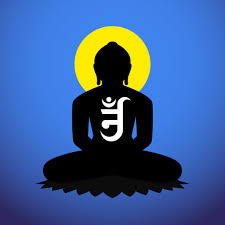1.
The earliest road to liberation which is still discernible in the texts, esp. in the Ayaranga, is a direct response to the idea that suffering is the result of activity. The evil effects of activity are avoided by renouncing activity. In this way no new karman is bound by the soul, and karman that had already been bound is destroyed, as the Uttarjjhayana (29.37/1139) explains. Renouncing activity is done in a most radical way, culminating in motionlessness until death. Motionlessness of the mind is but one aspect of this, which receives but little attention in the old texts. One earealy passage (Uttarajjhayana 29.72/1174) speaks of ‘pure meditation’ (sukkajjhana, Skt. Sukla dhyana), which is entered when less than the time of muhurta is left of life. In this pure meditation only subtle activity initially remains; then-after the activities of mind, speech had body, including breathing, have been stopped – the monk is in pure meditation in which all activity has been cut off, and in which the last remains of karman are being destroyed. The ninth (or eighth) chapter of Ayaranga I indicates that meditation (Jhana, Skt. Dhyana) was not confined to the last moments before death. Mahavira is here said to meditate ‘’day and night”. He is said to meditate on objects in the external world.
Besides these few early passages there are more extensive descriptions in later classificatory texts. The nature of these texts brought it about that everything that can be covered by the term Jhana is enumerated here. This is much more than ‘meditation’ alone; also `thinking’ is covered by this term. The resulting enumeration contains four types of dhyana: (1) afflicted (atta, Skt. arta), (2) wrathful (rodda, Skt. raudra), (3) pious (dhamma, Skt. dharmrmya), and (4) pure (sukka, Skt. sukla). They are described as follows in the Thapariga (4.61-72/247), and almost identically in the Vijyahapannatti and Uvavaiya:
These four kinds of dhyana, however, came to be looked upon four types of meditation, enumerated among the different kinds of inner asceticism; so Viyahapappatti 25.7.217, 237f./580, 600f, and Uvavaiya, section 30. (The confusion is complete in Avassaya Sutta 4.23.4, where the monk is made to repent these types of dhyana; obviously the first two are such as should be repented, and these are no forms of meditation.) the later tradition, when looking for canonical guidance regarding meditation, was henceforth confronted with a list of four kinds of ‘meditation’, only the last one of which, viz. ‘pure meditation’, should properly be regarded as such.
2.The strange confusion described in section 1 was followed by an even more dramatic development. ‘Pure meditation’ came to be considered inaccessible in the present age (in this world). Sometimes this is stated explicitly, as for example in Hemacandra’s Purvas in order to reach the first two stages of pure meditation. The fourteen Purvas once constituted the twelfth Anga of the Jaina canon, but they were lost at early date. Already the Taltvartha Sutra (9.40; see Brokhorst, 1985: 176, 179f.) states that knowledge of the Purvas is a precondition for entering pure meditation. This means that already in the time between 150 and 350 C.E., pure meditation was considered no longer attainable in this world.
Such an early date finds support elsewhere. We have seen that the canonical description of the four dhyanas assigns four reflections (anupreksa) each to dharmya dhyana and sukla dhyana, in the following manner:
In dharmya dhyana:
(1) reflection on being alone (eganuppeha, Skt. ekatvanupreksa)
(2) reflection on transitoriness ( aniccanuppeha, Skt. aniryanupreksa)
(3) reflection on there being no refuge (asarananuppeha, Skt. asarananupreksa)
(4) reflection on birth and rebirth of living beings (samsaranuppeha, Skt. samsaranupreksa)
In sukla dhyana:
- Reflection on infinity (anamtavattiyanauppeha)
- Reflection on change (vipparinamanuppeha)
- Reflection on what is inauspicious (asubhanuppeha)
- Reflection on sin (avayanuppeha)



